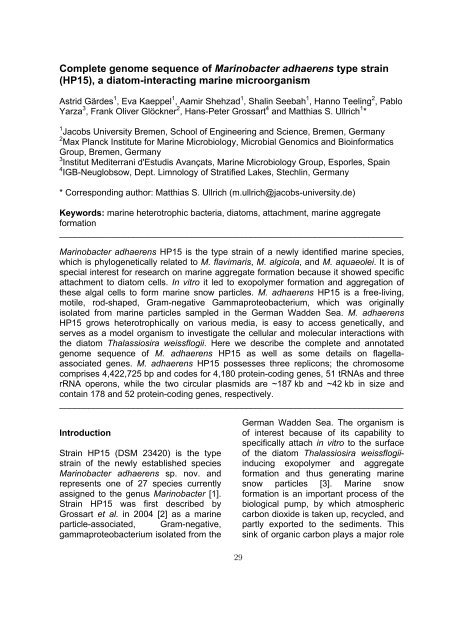h tQMQKB+ M/ ;2M2iB+ M HvbBb Q7 J `BMQ# + ... - Jacobs University
h tQMQKB+ M/ ;2M2iB+ M HvbBb Q7 J `BMQ# + ... - Jacobs University
h tQMQKB+ M/ ;2M2iB+ M HvbBb Q7 J `BMQ# + ... - Jacobs University
You also want an ePaper? Increase the reach of your titles
YUMPU automatically turns print PDFs into web optimized ePapers that Google loves.
Complete genome sequence of Marinobacter adhaerens type strain<br />
(HP15), a diatom-interacting marine microorganism<br />
Astrid Gärdes 1 , Eva Kaeppel 1 , Aamir Shehzad 1 , Shalin Seebah 1 , Hanno Teeling 2 , Pablo<br />
Yarza 3 , Frank Oliver Glöckner 2 , Hans-Peter Grossart 4 and Matthias S. Ullrich 1 *<br />
1 <strong>Jacobs</strong> <strong>University</strong> Bremen, School of Engineering and Science, Bremen, Germany<br />
2 Max Planck Institute for Marine Microbiology, Microbial Genomics and Bioinformatics<br />
Group, Bremen, Germany<br />
3 Institut Mediterrani d'Estudis Avançats, Marine Microbiology Group, Esporles, Spain<br />
4 IGB-Neuglobsow, Dept. Limnology of Stratified Lakes, Stechlin, Germany<br />
* Corresponding author: Matthias S. Ullrich (m.ullrich@jacobs-university.de)<br />
Keywords: marine heterotrophic bacteria, diatoms, attachment, marine aggregate<br />
formation<br />
______________________________________________________________________<br />
Marinobacter adhaerens HP15 is the type strain of a newly identified marine species,<br />
which is phylogenetically related to M. flavimaris, M. algicola, and M. aquaeolei. It is of<br />
special interest for research on marine aggregate formation because it showed specific<br />
attachment to diatom cells. In vitro it led to exopolymer formation and aggregation of<br />
these algal cells to form marine snow particles. M. adhaerens HP15 is a free-living,<br />
motile, rod-shaped, Gram-negative Gammaproteobacterium, which was originally<br />
isolated from marine particles sampled in the German Wadden Sea. M. adhaerens<br />
HP15 grows heterotrophically on various media, is easy to access genetically, and<br />
serves as a model organism to investigate the cellular and molecular interactions with<br />
the diatom Thalassiosira weissflogii. Here we describe the complete and annotated<br />
genome sequence of M. adhaerens HP15 as well as some details on flagellaassociated<br />
genes. M. adhaerens HP15 possesses three replicons; the chromosome<br />
comprises 4,422,725 bp and codes for 4,180 protein-coding genes, 51 tRNAs and three<br />
rRNA operons, while the two circular plasmids are ~187 kb and ~42 kb in size and<br />
contain 178 and 52 protein-coding genes, respectively.<br />
______________________________________________________________________<br />
Introduction<br />
Strain HP15 (DSM 23420) is the type<br />
strain of the newly established species<br />
Marinobacter adhaerens sp. nov. and<br />
represents one of 27 species currently<br />
assigned to the genus Marinobacter [1].<br />
Strain HP15 was first described by<br />
Grossart et al. in 2004 [2] as a marine<br />
particle-associated, Gram-negative,<br />
gammaproteobacterium isolated from the<br />
German Wadden Sea. The organism is<br />
of interest because of its capability to<br />
specifically attach in vitro to the surface<br />
of the diatom Thalassiosira weissflogiiinducing<br />
exopolymer and aggregate<br />
formation and thus generating marine<br />
snow particles [3]. Marine snow<br />
formation is an important process of the<br />
biological pump, by which atmospheric<br />
carbon dioxide is taken up, recycled, and<br />
partly exported to the sediments. This<br />
sink of organic carbon plays a major role
















